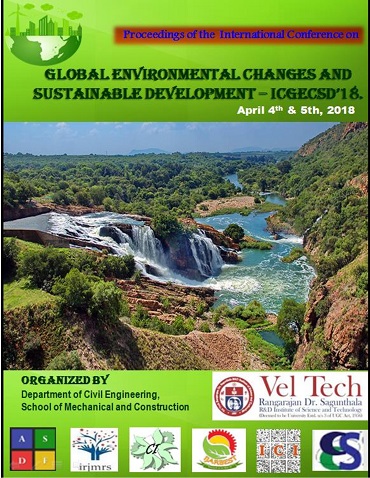- Publication Meta:Value
- Short Title:ICGECSD 2018
- Publisher:ASDF, India
- ISBN 13:978-81-933584-6-7
- ISBN 10:81-933584-6-5
- Language:English
- Type:Hard Bound - Printed Book
- Copyrights:ICGECSD Organizers / [email protected]
- Editor-in-Chief:Dr E B Perumal Pillai
- Conference Dates:04 - 05, April 2018
- Venue Country:Veltech R&D Institute of Science and Technology, Chennai, India
- Submitted Papers:230
- Acceptance Rate:8.12%
- Website:www.veltech.edu.in/icgecsd
Welcome to ASDF Electronic Digital Library!
ICGECSD 2018
ICGECSD 2018
International Conference on Global Environmental Changes and Sustainable Development 2018
Paper 036
Removal and Recovery of Lead from Electroplating Industrial Wastewater Using Chitosan
Rafik Raja1
1Assistant Professor, Department of Civil Engineering, Vel Tech High Tech Dr.Rangarajan Dr.Sakunthala Engineering College, Avadi, Chennai, India
Abstract
In recent years, environmental pollution with heavy metal has attracted the attention of many research groups worldwide. Contamination with these heavy metal has also increased public concerns because of their toxicities in relatively low concentration, their non-biodegradable nature and tendency of bioaccumulation. The increasing demand for the recovery of these metals from industrial effluents has stressed the development and the testing of new sorbing materials including use of abundant waste biomaterials. For last three to four decades, biopolymers have been extensively studied because of their interactions with metal ions. In this project, it is going to remove the lead metal from electroplating industrial waste water which was collected from an electroplating industry at Ambattur Industrial Estate, Ambattur, Chennai. Here, the adsorbent used is Chitosan, a Bioadsorbent in this project. Chitin is the main structural component of the exoskeleton of crustaceans (e.g., crabs, prawns, crabs, insects and shrimps) and the cell walls of fungi. Chitin is a polymer made up of acetylglucosamine units. In the case of some Mucorales species, chitin is replaced by chitosan, a polymer made up of glucosamine units.
Keywords
Author's Profile
Author profile can be generated and linked through our partners World Book of Researchers. To include your profile online Click Here. After it is approved, please email to edlib @ asdf.res.in to create a link with all the papers.
e-AID
ICGECSD.2018.036
Cite this Article as Follows
Rafik Raja. Removal and Recovery of Lead from Electroplating Industrial Wastewater Using Chitosan. International Conference on Global Environmental Changes and Sustainable Development (2018): 36. Print.
© 2010 - by EDLIB .
All Rights Reserved.

